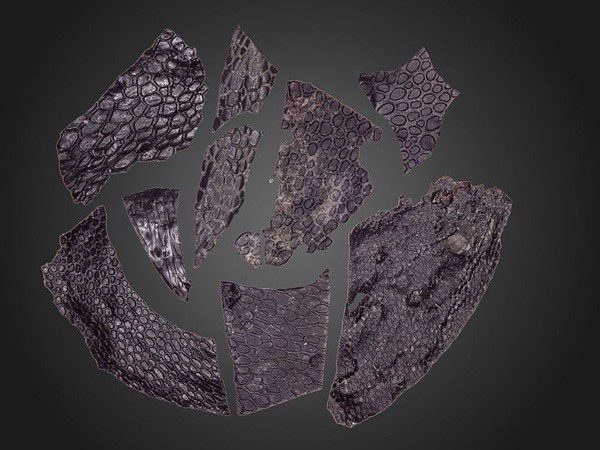The oldest known fossilized skin fragment in the world belongs to a reptile species that lived before dinosaurs roamed the Earth.
A new study reveals that the fossilized reptile skin, discovered in a limestone cave in Oklahoma, USA, dates back at least 130 million years earlier than the previously known oldest skin fossil.
According to a press release issued on January 11, 2024, researchers from the University of Toronto Mississauga identified a fragment of skin with a pebbly texture similar to that of crocodile skin.
Dating back approximately 289 million years, this is the oldest known preserved epidermis, representing the outer skin layer of reptiles, birds, and terrestrial mammals.

Fragment of skin with a pebbly texture similar to that of crocodile skin.
The article states that the epidermis “is a crucial evolutionary adaptation in the transition to life on land.”
Lead author Ethan Mooney, a graduate student in paleontology at the University of Toronto, stated, “Occasionally we have a unique opportunity to look back deep in time. Discoveries like this can truly enrich our understanding and awareness of these pioneering animals.”
Co-author Robert Reisz, a biology professor at the University of Toronto Mississauga specializing in vertebrate paleontology, told CNN that “finding fossilized skin is very rare”, “despite the fact that it is the largest organ in the body.”
“It decays very easily after the animal dies,” Reisz explained, noting that this specimen was preserved due to the unique characteristics of the Richards Spur limestone cave system, which has yielded many of the earliest examples of terrestrial animals.
“The conditions in the cave are quite unusual,” Reisz told CNN, citing the chemical properties of the clay sediments, water, and the presence of hydrocarbons.
Animals that fell into the cave system were buried in fine clay sediments, slowing the decomposition process and subsequently interacting with hydrocarbons in seep oil, which preserved the skin.
According to the researchers, this cave may also have been an anoxic environment.
Professor Reisz mentioned to CNN that this specimen is one of thousands donated to the team by amateur collector Bill May in 2018.
Most of the samples are bones and easily recognizable. However, this “fragile” skin fossil is unique, with a thickness of about 1/4 mm or less.
The research team discovered epidermal tissues while examining the small fossilized skin, which is smaller than a fingernail.
“We were completely shocked by what we saw because it was nothing like we expected. Finding such an ancient skin fossil is a special opportunity to look back in time and see what the skin of some of these early animals might have looked like,” Mooney stated.
The researchers noted that the skin surface has a pebble-like texture similar to crocodile skin, with hinge areas between scales resembling those of snakes and lizards.
Despite these characteristics, the researchers could not determine which animal or body region the specimen originated from, as the fossil was not associated with any other remains.
However, Reisz told CNN that the skin likely belonged to “a small animal that looked somewhat like a lizard.” He believes this skin could belong to a small reptile called Captorhinus, whose fossils are found in the cave system much more frequently than any other animal.
Nonetheless, the similarities of this specimen to living reptiles underscore the importance of skin for terrestrial animals.
“The epidermis is a critical feature for the survival of terrestrial vertebrates. It serves as a vital barrier between the internal processes of the body and the harsh external environment,” Mooney explained.
Additionally, this specimen may represent an example of skin structure that eventually evolved into feathers in birds and fur in mammals, according to the article.


















































